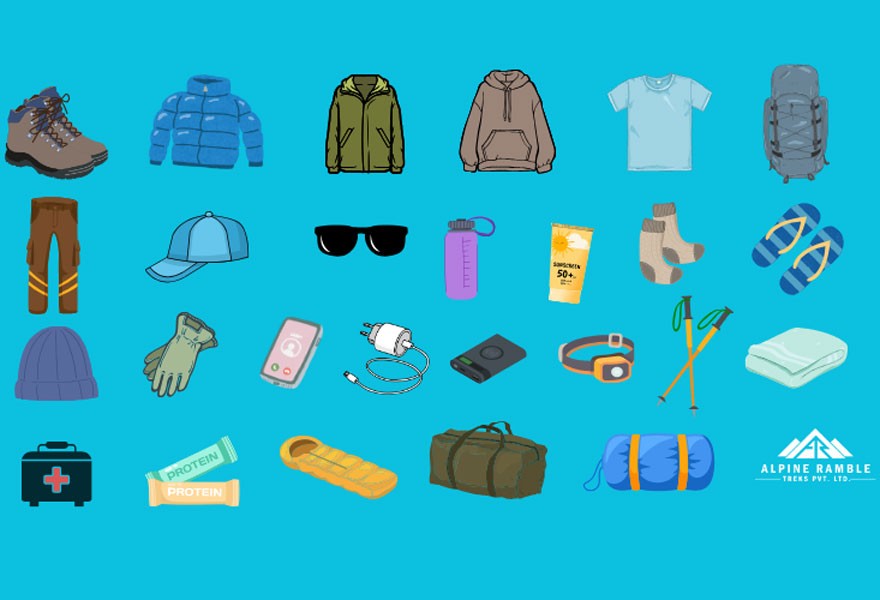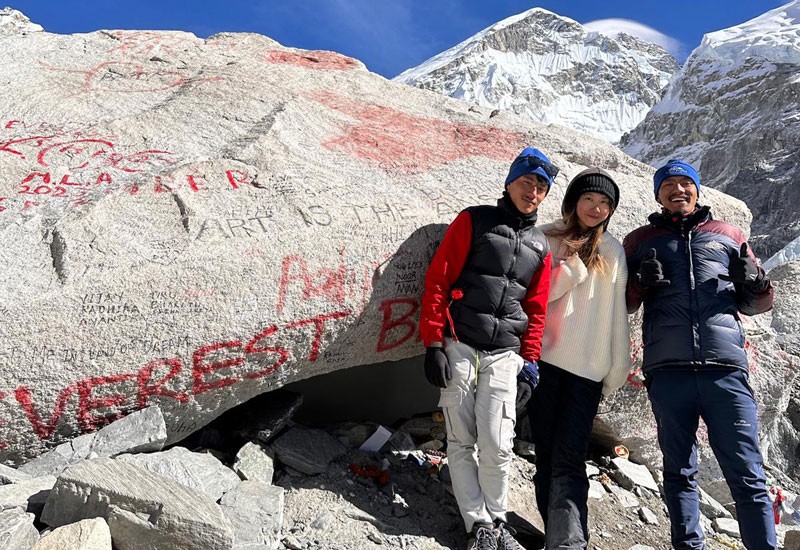
Trekking in Nepal
By Alpine

Everest Base Camp, a trekking destination everyone dreams about going to at least once in their lifetime. The perfect blend of nature, culture, and mountains that will leave you with some of the best memories in your life.
Perhaps you might be planning for the trek in the coming future but are confused. Because what does one pack for a trek?
Especially to trek the Everest Base Camp! But do not worry; on this blog, we will break down a comprehensive packing list for you. Not only will we let you know what you should pack and why, but also what you should not pack.
First, let’s break down the general information you need to know before embarking on the journey of trekking to the Everest Base Camp.
Yes, it is indeed cold in the Everest Base Camp. However, the range of cold depends on the location along with the season. The higher you are on the elevation, the colder it is.
For instance, Gorakshep, at an altitude of 5,164 meters (16,942 feet), is much colder than Lukla, which is only 2,860 meters (9,383 feet) above sea level. Which is why you will need a variety of clothing that ranges from light t-shirts to well-padded down jackets.
Nepal has four seasons, categorized as summer, winter, spring, and autumn. While it is very common for most trekkers to choose spring and autumn for trekking in the Himalayas due to the moderate temperature and clear weather, summer and winter are also very much trekkable.
While the summer season is not as cold as the winter, it comes with its own challenges, such as rainfall due to the monsoon. But winter is the coldest, as one would expect. The average low temperature in the Khumbu region can range from -5°C during the summer to -20°C in the winter.
The weather during the day is generally clear and sunny but can get quite windy past the afternoon. Thus, this might give you a perspective on how cold the Everest Base Camp really is during the time of your visit and adjust your packing accordingly.
As you will be traveling for a significant number of days, you will have to carry an adequate amount of clothes and personal items. While many of the things might come in handy during the trek, some of them are just going to be useless. The company you choose often gives you free service to store your belongings. In fact, some hotels will provide the same service.
With the total weight limit on a flight to Lukla being 15 kg in total, you will have to be very sure of what you need and do not need. As a complimentary service, our company will provide you with duffle bags for your belongings. And you can hire a porter to carry the extra bags you will require during the trek.
Yes, you absolutely can. But the options are limited to what you can buy here. So, if you fancy a product of a certain brand, it might not be available in Kathmandu.
Therefore, we suggest you do some research beforehand while making the decisions. Especially when you buy shoes, they need to be well broken down before the trek. It is the one thing you should not compromise on.
The gear, such as duffle bags, trekking poles, and down jackets, can be easily rented in Thamel, Kathmandu. Many people rent the gear for a number of reasons, one of the main being they will not use the gear again or they simply cannot add extra weight when they fly back.
But whatever your reason might be, you can buy or rent any gear or clothes you require for the trek in Kathmandu.
And if you have to do last-minute shopping, you can also buy gear in Lukla and Namche Bazaar. Hence, making sure you have everything you need prior to your trek is extremely crucial.
Hiring a porter is not mandatory; however, it certainly makes your trek a whole lot easier. If you are confident in your own strength and abilities, you can choose to not hire a porter and carry all your belongings by yourself.

But please keep in mind that your backpack will have all the necessary items for the trek and can weigh anywhere around 8–10 kg. That being said, it is not something impossible, as a lot of trekkers prefer to do it by themselves.
So, you should be mentally and physically prepared to carry a significant amount of weight on your back. Therefore, training for the Everest Base Camp Trek is fundamental.
Now, if you are someone who plans on hiring a porter, then it can be done very easily. The porters usually have a weight limit of around 20 kg and charge $25 per day, but this can vary.
By hiring a porter, you can trek without the heavy weight on your back and feel lighter while you trek. But it does not mean you will not carry anything at all; you will have a small backpack with important things like a water bottle, dry food, and a spare jacket for when you need it, along with your important documents and money.
The porters carrying your duffle bags will always move faster than you, so it is crucial that you carry your own backpack with essential items.
Let's talk about the essentials for packing for the Everest Base Camp Trek. No matter if it is your first or 15th time trekking, having a packing list can be a big help.
Especially for those who are just venturing out into the world of trekking, it can be a bit overwhelming trying to keep up with everything you need to pack for the trek.
And the last thing you need is to forget something very important and realize it halfway through the trek. But we are here to make things easier for you and provide you with a comprehensive packing list for the Everest Base Camp Trek.
Now that we have established a comprehensive list let's dive deeper into how to pack efficiently without any unnecessary items to add more weight to your backpack.
While you are packing your trekking bag, you should not add everything haphazardly. Things you won’t need till the end of the day should be at the absolute bottom of the bag, while things you will frequently need or may need should be at the top, with other items in between.
Imagine it suddenly started raining in the middle of the hike and you cannot locate your raincoat because you put it at the very end of the bag.
This way, not only will you get wet but all your clothes too. So, you need to be smart and efficient when packing.
Let us discuss what it means below!
As mentioned above, items that are important and frequently used or might be required should be at the top. Items such as sunscreen, raincoats, fleece jackets, medications, and other things you deem essential. It should be at such a place that will not require you to rummage through your backpack for more than a minute.
Another important thing is that your trekking backpack should be balanced with the center of gravity close to your lower back. It will help you carry your bag more easily with weight distributed more on your hips, and your back and shoulders will not be impacted.
Unbalanced bags will put more pressure on your shoulders and pull your weight backward, making it uncomfortable to trek and causing back and shoulder pain.
Your clothes should be compressed while putting them in the bag. More air means less space for your clothes. If your clothes are not compressed while packing, it will take up more space, and everything will not fit. And the bag will also not be balanced once you are done.
Make sure you do not have a bottle filled with water in the middle of your bag, along with all the clothes. That is just a disaster waiting to happen. Keep your dry and wet items separately in a dry bag to prevent spillage. Even small items like wet wipes can make your entire bag wet due to the compression. Therefore, make sure you know your dry and wet items are separate.
Make sure to keep everything you have inside the bag. Sometimes, hikers will leave a towel, socks, or even t-shirts or pants hanging on the bag to dry. It not only looks bad but also can get tangled on tree branches or get blown away with the wind.
Along with smart packing, you also need to be smart about how you wear your trekking clothes. Layering is the best way to maximize the function of the trekking clothes while experiencing a seamless trek. There are three parts to layering, and they are:
The base layer, also known as the inner layer, is the very first layer you put on. They are made of synthetic materials designed to preserve your body heat while helping to dry off sweat or wetness very fast. The base layer helps to create insulation even when you get wet.
The middle layer is the fleece jacket or sweater, which creates a barrier that prevents the outside cold from entering your body, keeping you warm and toasty.
The mid-layer should have a good breathable space, letting the air in while maintaining sweat retention. The middle layer of clothes should be thick so that it can keep you warm.
The outer layer is the Gore-Tex wind and waterproof jacket and down jacket, which protects you from the outside elements such as cold, wind, and rain.
This is the protective layer, so make sure you have the best quality clothing, as one of your main priorities is to avoid getting wet and cold. Getting wet by the rain or even due to excessive sweat can lead to hypothermia.
All three layers should be constructed in a well manner. A proper layering will enable you to have a splendid trek without excessive sweating, as there will be good ventilation, keep you warm because of the insulation, which will store your body heat while not letting the cold in, and last but not least, the outer layer will save you from rain, wind, and snow.
Hopefully, this comprehensive guide to the packing list for the Everest Base Camp Trek will be insightful and helpful for when you begin your journey. Remember, this list is useful not only for the Everest Base Camp Trek but also for the Gokyo Lakes Trek, the Everest Three High Pass Trek, the Annapurna Base Camp Trek, and other Himalayan treks in Nepal.
If you want us to assist you through your trekking journey, no matter which place in Nepal you choose, we are ready to be of service to you. For more details, please email alpineramble@gmail.com or WhatsApp at +977 985-1175531 and let us be at your service.